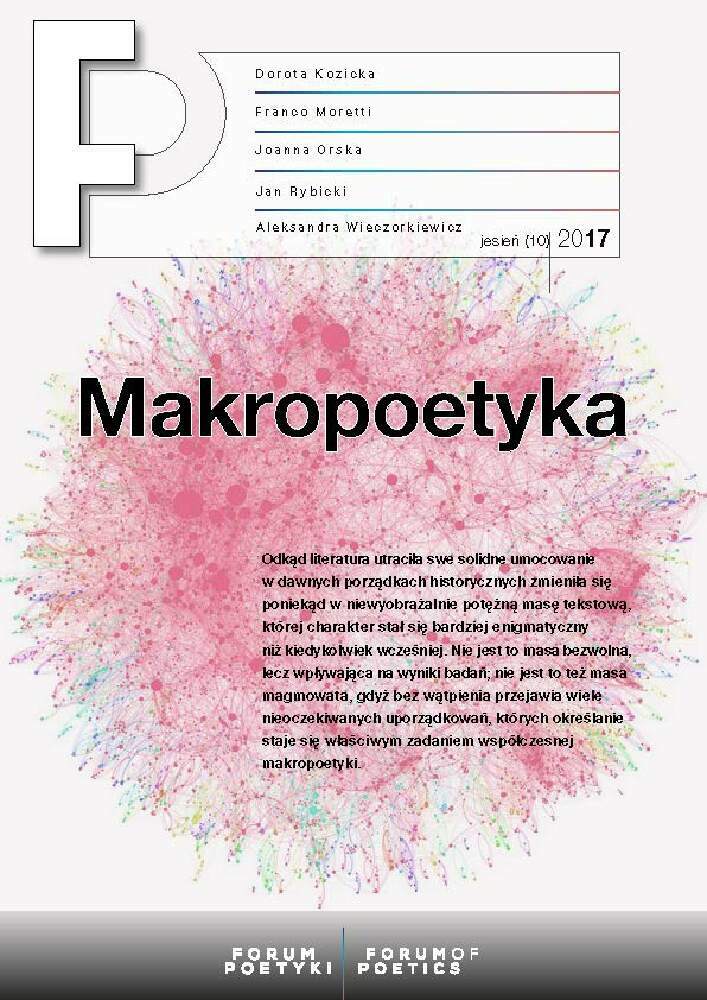Abstrakt
W artykule przedstawiono wyniki analizy ilościowej najczęstszych słów korpusu ponad 2500 tekstów polskich: literatura polska od XIV do XXI wieku oraz polskie przekłady z angielskiego, francuskiego, rosyjskiego i (w mniejszym stopniu) innych języków. Wykazano istnienie w korpusie silnego sygnału rodzajowego i sygnału języka wyjściowego. Wyniki wskazują również na wyraźną odrębność stylometryczną języka polskich przekładów szekspirowskich i ich bardzo silne podobieństwo stylometryczne do polskiego dramatu romantycznego i neoromantycznego.
Bibliografia
Bastian, Mathieu, i Sebastien Heymann. „Gephi: An Open Source Software for Exploring and Manipulating Networks”. International AAAI Conference on Weblogs and Social Media, 2009.
Blondel, Vincent D, Jean-Loup Guillaume, Renaud Lambiotte, i Etienne Lefebvre. „Fast unfolding of communities in large networks”. J. Stat. Mech. Journal of Statistical Mechanics: Theory and Experiment, nr 10 (2008).
Burrows, John. „Delta: A Measure of Stylistic Difference and a Guide to Likely Authorship”. Literary and Linguistic Computing 17 (2002).
Burrows, John. „The Englishing of Juvenal: Computational Stylistics and Translated Texts”. Style 36, nr 4 (2002): 677–98.
Burrows, John. „Tiptoeing into the Infinite: Testing for Evidence of National Differences in the Language of English Narrative”. W Research in Humanities Computing, zredagowane przez Susan M Hockey i Nancy Ide. Oxford: Oxford University Press, 1996.
Burrows, John Frederick. Computation into criticism: a study of Jane Austen’s novels and experiment in method. Oxford: Clarendon Press, 1987.
Connors, Luisa. Computational Stylistics, Cognitive Grammar, and the Tragedy of Mariam: Combining Formal and Contextual Approaches in a Computational Study of Early Modern Tragedy. Newcastle: University of Newcastle, 2013.
Eder, Maciej. „Does size matter? Authorship attribution, small samples, big problem”. Literary and Linguistic Computing, nr 30 (2015).
Eder, Maciej. „Metody ścisłe w literaturoznawstwie i pułapki pozornego obiektywizmu: przykład stylometrii”. Teksty Drugie : teoria literatury, krytyka, interpretacja 2014, nr 2 (2014): 90–105.
Eder, Maciej. „Visualization in Stylometry: Cluster Analysis Using Networks”. Digital Scholarship in the Humanities 32, nr 1 (2017): 50–64.
Eder, Maciej, Rafał Górski, i Jan Rybicki. „Stylistic Fingerprints, POS Tags and Inflected Languages: A Case Study in Polish”. W Qualico 2014: Book of Abstracts. Olomouc: Palacky University, 2014.
Eder, Maciej, Mike Kestemont, i Jan Rybicki. „Stylometry with R: A Package for Computational Text Analysis”. R J. R Journal 8, nr 1 (2016): 107–21.
Evert, Stefan, Thomas Proisl, Fotis Jannidis, Isabella Reger, Steffen Pielström, Christof Schöch, i Thorsten Vitt. „Understanding and Explaining Delta Measures for Authorship Attribution”. Digital Scholarship in the Humanities 32 (2017). https://academic.oup.com/dsh/article-abstract/doi/10.1093/llc/fqx023/3865676/Understanding-and-explaining-Delta-measures-for.
Hoover, David. „Quantitative Analysis and Literary Studies”. W A Companion to Digital Literary Studies, zredagowane przez Raymond George Siemens i Susan Schreibman. Oxford: Blackwell, 2007.
Jacomy, Mathieu, Tommaso Venturini, Sebastien Heymann, Mathieu Bastian, i Mark R Muldoon. „ForceAtlas2, a Continuous Graph Layout Algorithm for Handy Network Visualization Designed for the Gephi Software”. PLoS ONE 9, nr 6 (2014).
Jockers, Matthew Lee. Macroanalysis: digital methods and literary history. Champaign: University of Illinois Press, 2013.
Krajewska, Wanda. Recepcja literatury angielskiej w Polsce w okresie modernizmu (1887–1918). Informacje. Sądy. Przekłady. Wrocław: Zakład Narodowy im. Ossolińskich, 1972.
McCarty W, i McCarty W. „Getting There from Here. Remembering the Future of Digital Humanities: Roberto Busa Award Lecture 2013”. Literary and Linguistic Computing 29, nr 3 (2014).
Moretti, Franco. Wykresy, mapy, drzewa. Abstrakcyjne modele na potrzeby historii literatury. Kraków: Wydawnictwo Uniwersytetu Jagiellońskiego, 2016.
R Core Team. „R: A language and environment for statistical computing”. Udostępniono 14 lipiec 2017. http://www.R-project.org/.
Rizzo, Maria L. Statistical Computing with R, 2019. https://search.ebscohost.com/login.aspx?direct=true&scope=site&db=nlebk&db=nlabk&AN=2084492.
Rybicki, Jan. „Pierwszy rzut oka na stylometryczną mapę literatury polskiej”. Teksty Drugie : teoria literatury, krytyka, interpretacja 2014, nr 2 (2014): 106–28.
Rybicki, Jan. „Stylometric Translator Attribution: Do Translators Leave Lexical Traces?” W The translator and the computer, zredagowane przez Tadeusz Piotrowski i Łukasz Grabowski. Wrocław: Wydawnictwo Wyższej Szkoły Filologicznej, 2013.
Rybicki, Jan. „The Great Mystery of the (Almost) Invisible Translator: Stylometry in Translation”. W Quantitative Methods in Corpus-Based Translation Studies. Apractical Guide to Descriptive Translation Research, zredagowane przez Michael P Oakes. Amsterdam: J. Benjamins, 2012.
Rybicki, Jan. „Vive la différence: Tracing the (authorial) gender signal by multivariate analysis of word frequencies”. Digital Scholarship in the Humanities 31, nr 4 (2016): 746–61.
Rybicki, Jan, i Maciej Eder. „Deeper Delta across genres and languages: do we really need the most frequent words?” Literary and Linguistic Computing 26, nr 3 (2011).
Rybicki, Jan, i Magda Heydel. „The stylistics and stylometry of collaborative translation: Woolf’s Night and Day in Polish”. Literary and Linguistic Computing, nr 4 (2013).
Sedelow, Sally Yeates, i Walter A Sedelow. A Preface to Computational Stylistics. Santa Monica: System Development Corp., 1964.
Smith, Peter, i John W. Aldridge. „Improving Authorship Attribution: Optimizing Burrows’ Delta Method”. Journal of Quantitative Linguistics 18, nr 1 (2011): 63–88.
Stachurski, Edward. Słowa-klucze polskiej epiki romantycznej. Kraków: Wydawnictwo Naukowe AP, 1998.
Walter, K. , K. Price, i Christof Schoech. „Fine-tuning our stylometric tools: Investigating authorship, genre, and form in French classical theater”. W Digital Humanities 2013 Conference Abstracts. Lincoln, 2013
Licencja
Za prawa cytowania fragmentów innych publikacji (tekstów, tabel, rycin oraz ilustracji) odpowiedzialni są autorzy artykułu.

